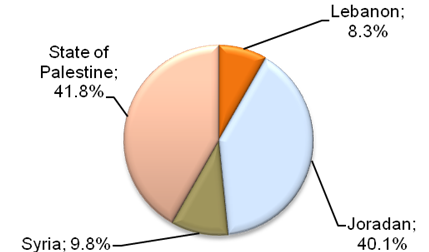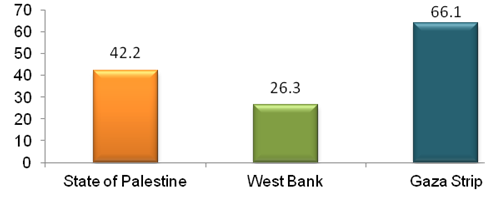H.E. Dr. Ola Awad, President of the Palestinian Central Bureau of Statistics (PCBS)
Highlights the conditions of the Palestinian people through statistical figures and findings, on the occasion of World Refugee Day, 20/06/2025
Horrific numbers of martyrs and injured, mostly are children and women, in light of the ongoing Israeli occupation aggression
The number of Palestinian and Arab martyrs killed since the Nakba in 1948 and until this day (inside and outside Palestine) reached more than 156 thousand martyrs. The number of martyrs in Palestine since the start of the Israeli occupation aggression against Gaza Strip on October 7th, 2023 until to 18/06/2025, reached more than 55 thousand martyrs; more than 18 thousand children and more than 12 thousand women, in addition to more than 219 journalists were martyred and more than 11 thousand missing citizens, most of whom were women and children. In the West Bank, at least 991 people have been martyrs since the beginning of the aggression on October 7, 2023. In light of the occupation's escalation of its military operations and ongoing violations against civilians Gaza Strip has witnessed widespread internal displacement, with nearly 2 million citizens forced to leave their homes and seek refuge in safer areas within the Strip, exacerbating the worsening humanitarian crisis in the Strip.
Ethnic cleansing, displacement of Palestinians and settler colonialism
The Nakba in Palestine describes a process of ethnic cleansing in which an unarmed nation was destroyed and its population was displaced systematically by gangs and individuals from all over the world. The population of historic Palestine in 1914 was approximately 690 thousand, of whom Jews constituted only 8%. In 1948, the population exceeded 2 million, approximately 31.5% of whom were Jews. The largest influx of Jewish immigrants, 225 thousand, occurred between 1932 and 1939. Between 1940 and 1947, more than 93 thousand Jews arrived in Palestine. Thus, between 1932 and 1947, Palestine forcibly received approximately 318 thousand Jews, and from 1948 until 2023, more than 3.3 million Jews have arrived.
Despite the displacement of 957 thousand Palestinians in 1948 and more than 200 thousand Palestinians after the war of June 1967, the estimated population of the State of Palestine reached approximately 5.5 million Palestinians by mid-2025 ((3.4 million in the West Bank and 2.1 million in Gaza Strip (a 10% decrease compared to the population estimates for Gaza Strip for 2025)). Based on revised population estimates prepared by the Palestinian Central Bureau of Statistics, there were 15.2 million Palestinians in the world by mid-2025, more than half of whom were outside historic Palestine (7.8 million, of them 6.5 million in Arab countries). Their number reached approximately 7.4 million Palestinians in historic Palestine.
The Displacement of Approximately 2 Million Palestinians inside Gaza Strip, Far from their Places of Residence
People of Gaza has repeatedly been forced to leave their homes under duress. They have lost their houses and become refugees living in tents and in schools, trapped within walls of poverty and war, Approximately two million Palestinians have been displaced from their homes, out of a total of approximately 2.2 million Palestinians who lived in the Strip on the eve of the Israeli occupation's aggression. Refugees constitute 66% of Gaza Strip's population.
Furthermore, thousands of Palestinian citizens, including men, women, and children, have been unlawfully detained by Israeli occupation forces in the West Bank and Gaza Strip. A number of men, women, and children have also been forcibly abducted from Gaza, and tens of thousands have been displaced.
In the West Bank, similar to the Nakba of 1948 and the Naksa of 1967, thousands of Palestinians were forcibly displaced from their homes in refugee camps in the cities of Jenin, Tulkarm, and Tubas as a result of Operation Iron Wall, launched by the Israeli occupation army. This displacement occurred in the largest displacement operation the West Bank has seen in eight decades.
This displacement was described as the most dangerous, violent, and brutal of the many displacement operations that accompanied previous Israeli incursions into refugee camps in the northern West Bank (Jenin and Tulkarm) since the war on Gaza on October 7, 2023. Palestinians were displaced individually and in groups from their homes, which had been destroyed by the occupation, to destinations known to some, such as the homes of relatives and friends, while others sought refuge in shelters such as mosques, clubs, and schools.
The Palestinians were forced to flee their destroyed homes, individually and in groups. Some sought refuge in the homes of relatives and friends, while others found temporary shelter in places like mosques, community centers, and schools.
According to data from the United Nations Relief and Works Agency for Palestine Refugees (UNRWA), the number of Palestinian refugees displaced from refugee camps in the northern West Bank has increased to more than 42,000 due to the ongoing Israeli aggression, as well as the ongoing forced displacement, home demolitions, and ongoing arrest campaigns. The number of displaced persons from Jenin Refugee Camp and its surroundings has increased to 21,000 people, representing 30% of the population of Jenin City and Refugee Camp. Meanwhile, most of the residents of Tulkarm and Nur Shams Refugee Camps, estimated by PCBS at about 19,000 refugees, were displaced by mid-2025.
More than 6 Million Registered Refugees with UNRWA in Palestine and Diaspora
UNRWA records indicated that the number of registered Palestinian refugees in August 2023 amounted up to about 5.9 million; about 2.5 million of them are in the West Bank and Gaza Strip, where they constitute more than 42% of the Palestinian refugees (15% in the West Bank and 27% in Gaza Strip ). At the level of the Arab countries, the percentage of Palestinian refugees registered with UNRWA in Jordan, amounted up to about 40% of the total Palestinian refugees while the percentage of Palestinian refugees registered with UNRWA in Lebanon and Syria reached about 8% and 10%, respectively. These estimates represent the minimum number of Palestinian refugees, taking into account that they are unregistered refugees, as this number does not include those Palestinians who were displaced after 1949 until the eve of the war of June 1967, “according to UNRWA’s definition.” It also does not include Palestinians who left or were deported in 1967 on the grounds of war and those who were not refugees in the first place.
Percentage Distribution of Palestinian Refugees by Country of Residence in August 2023

Source: United Nations Relief and Works Agency for Palestine Refugees in the Near East (UNRWA)
Number of Official Palestinian Refugee Camps as Recognized by UNRWA by
Country of Residence

Source: United Nations Relief and Works Agency for Palestine refugees in the Near East (UNRWA)
About 66% of the Total Population in Gaza Strip are Refugees
The percentage of the population of refugees in the State of Palestine in 2017 reached about 42.2% of the total Palestinian population residing in the State of Palestine, and data indicated that 26.3% of the population in the West Bank are refugees, while the percentage of refugees in Gaza Strip is 66.1%.
Percentage of Refugees in the State of Palestine by Region, 2017

Source: Palestinian Central Bureau of Statistics, 2018. Population, Housing and Establishments Census 2017: Census Final Results - Summary. 2017. Ramallah - Palestine.
 عربي
عربي